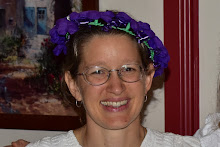I love homeschooling.
At breakfast time on Tuesday, P started with "Two ones is 2, two 2s is 4, two 4s is 8, and two 8s is 16." E then asked me, "What are two 100s?" I doubled for him until we got to 409 600, whereupon folding the laundry and feeding the baby took up too much of my attention.
The interest both P and E had showed in doubling suggested to me that I abandon my original plans for math (which weren't anything special, anyway) and let P practice addition by doubling until she lost interest. She didn't. We started by writing the doubles on the chalkboard, but soon ran out of space. I copied the answers we had so far onto a piece of paper. P struggled to write neatly enough to line up the problems exactly, so I set up each subsequent problem for her on the chalkboard, she solved it, and I wrote it on the paper. By the time we got to 262 144, P was not only not losing interest, she was excited. "Mommy, math is so much fun!" I began to think of possible strategies for ever stopping her, because the boys were getting bored (B was trying to eat the chalk each time P put it down).
Half a year ago or so, we read a picture book in which a girl tricks a greedy king by asking for a grain of rice as a reward, doubled daily for a month. So I suggested that P calculate how much rice the king gave the girl on the 31st day, and then stop. She added excitedly, finally concluding that the total was 1 073 741 824 grains of rice. While P worked, E kept commenting, "That king must be getting worried!" I only pointed out 2 minor errors during the course of this monumental calculation, which P corrected herself.
While P was busy, I had been reflecting on the fact that Sonlight's Core K, which we're using this year, contains a longer book with the same basic storyline. So, once P was done, we read A Grain Of Rice and thoroughly enjoyed it. The story was well told and both P and E followed it with enthusiasm. We compared the amount of rice the emperor was having to give the peasant each day with P's calculations, and it was fun to see them line up perfectly.
I'm convinced that a good teacher is always learning. Of course, I find math enough fun that I'm reading this book as my Sunday rest book (and at other times during the week too). I just read about a method of multiplying 2 numbers that requires only addition, doubling, and halving. (You can read about it here). We've covered addition and doubling already - when it comes time to teach P about multiplication (which she can already do, she just doesn't know it) this might be a neat thing to show her. I love that even with elementary math, there's something new for me to think about.

